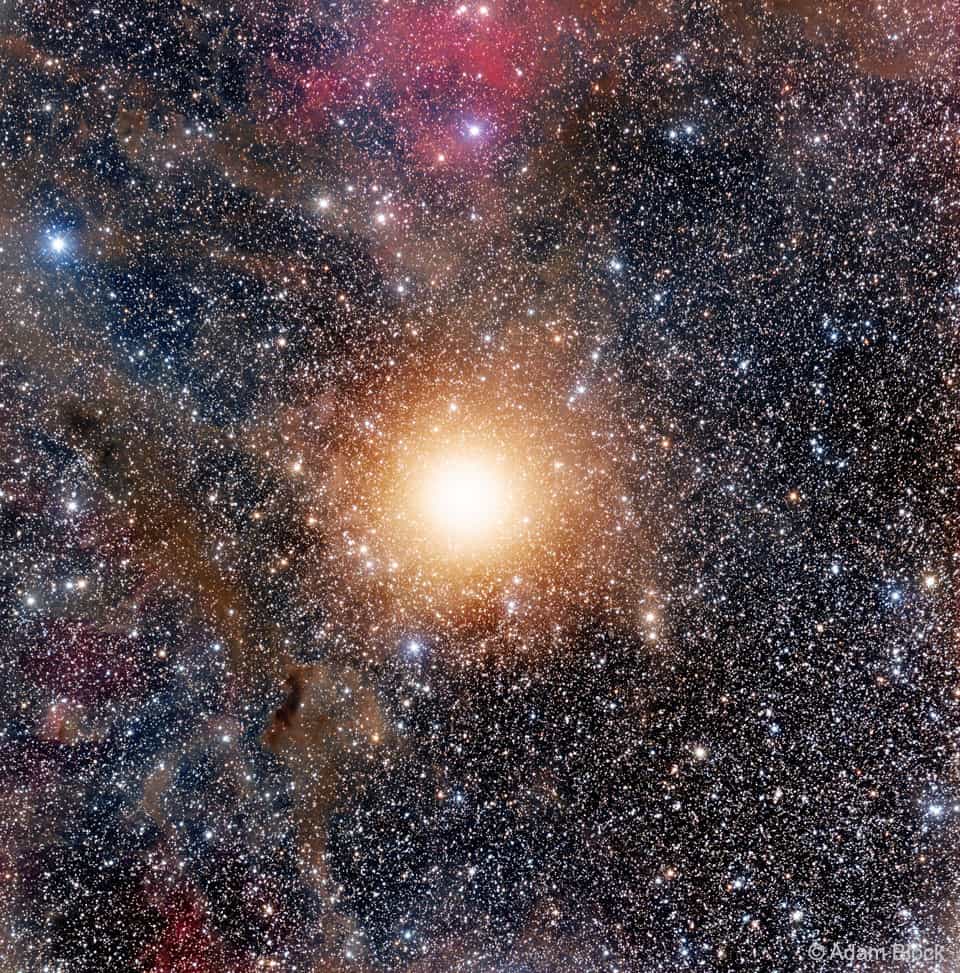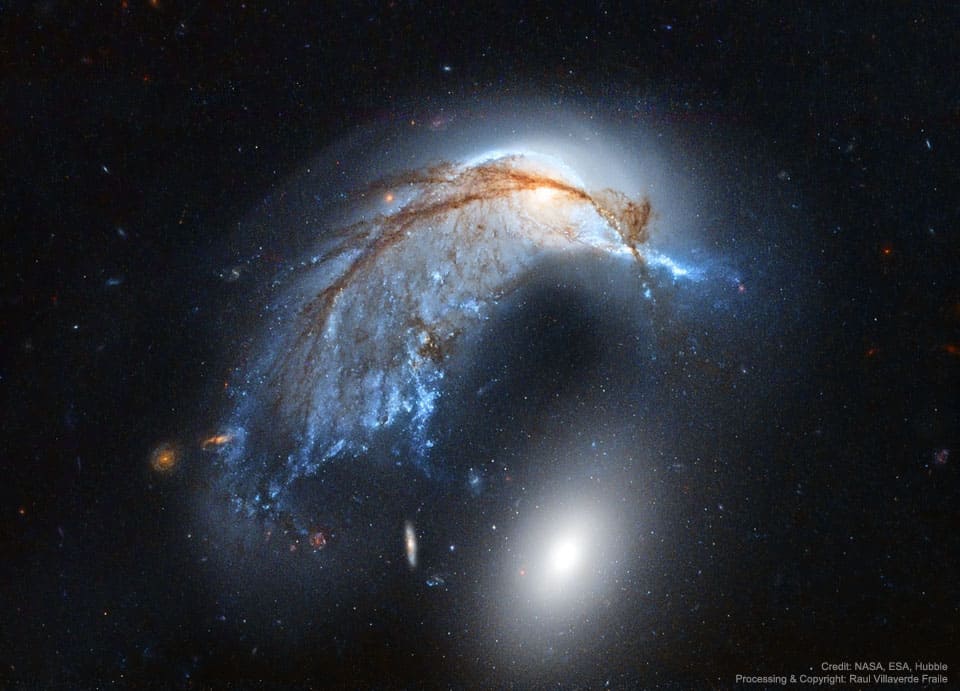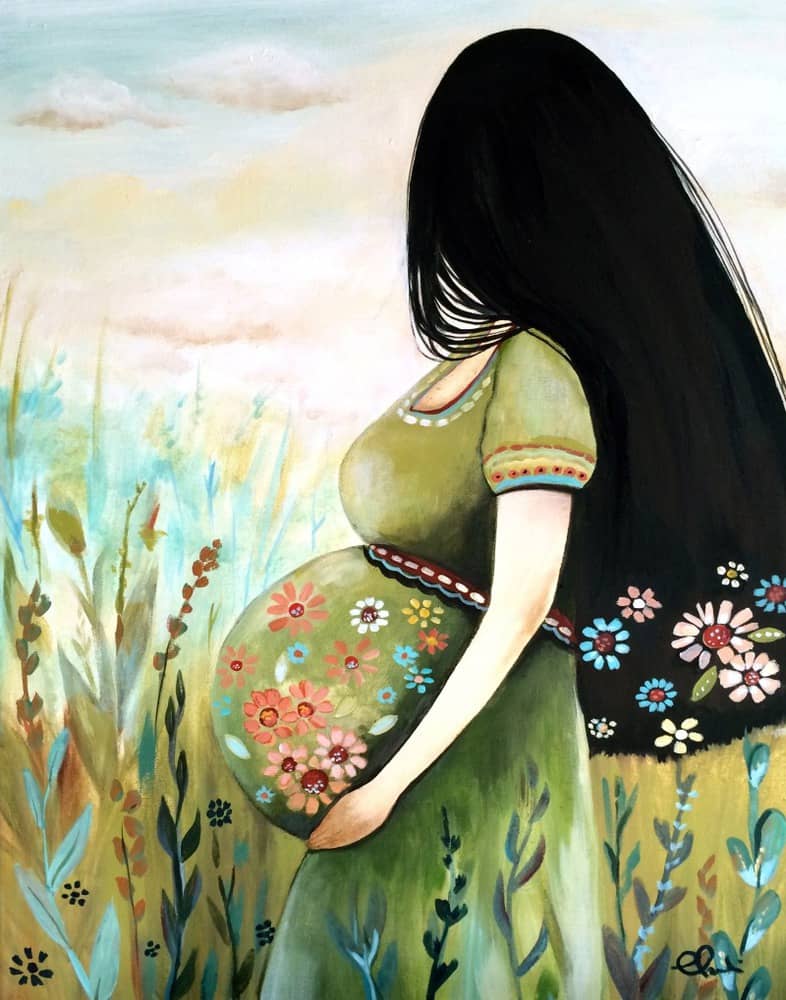Blog
One of the brighter and more unusual stars in the sky, the red supergiant star Betelgeuse can be found in the direction of famous constellation Orion. Betelgeuse, however, is actually well in front of many of the constellation’s other bright stars, and also in front of the greater Orion Molecular Cloud Complex. Numerically, light takes about 700 years to reach us from Betelgeuse, but about 1,300 years to reach us from the Orion Nebula and its surrounding dust and gas. All but the largest telescopes see Betelgeuse as only a point of light, but a point so bright that the inherent blurriness created by the telescope and Earth’s atmosphere make it seem extended. In the featured long-exposure image, thousands of stars in our Milky Way Galaxy can be seen in the background behind Betelgeuse, as well as dark dust from the Orion Molecular Cloud, and some red-glowing emission from hydrogen gas on the outskirts of the more distant Lambda Orionis Ring. Betelgeuse has recovered from appearing unusually dim over the past six months, but is still expected to explode in a spectacular supernova sometime in the next (about) 100,000 years.

May-11-1976
Greek oudist, pianist and composer Alekos Vretos has been merging jazz, Arabic, Greek and Latin music in a masterful blend of sounds from traditional instruments, such as the oud or the nay, vs. the modern ones. As a bandleader, Alekos has developed a unique atmosphere for his music: keeping traditional sound in the front line, he expands it through jazz improvisation and exploding rhythmic development.
In 2014, Alekos released his 2nd personal CD K. on Top. A long way musically from his previous work Mergin K. on Top is a statement of how World music and Jazz should be mixed without becoming to separate genres in one piece. Mature and stable, he is walking the line of good and tasteful musicianship overall. For his work and help towards the music scene (especially World Jazz), he was included in 2013 list of the 100+1 most influential people in the Greek music scene published by the Athens Voice newspaper.
more...Eric Victor Burdon (born 11 May 1941) is an English singer-songwriter and actor. He was previously the vocalist of rock band The Animals and funk band War. He is regarded as one of the British Invasion‘s most distinctive singers with his deep, powerful blues-rock voice. He is also known for his aggressive stage performances.
In 2008, he was ranked 57th in Rolling Stone‘s list The 100 Greatest Singers of All Time.
Eric Burdon was born in 1941 in Walker, Newcastle upon Tyne, England. His father, Matt, was originally from Tyneside. His mother, Rene, was originally from Ireland and moved to Scotland before settling in Newcastle in the 1930s. He also had a younger sister, Irene. Burdon later recalled that his middle name “Victor” had been chosen after encouragement from the Lord Mayor, who offered new mothers £25 if their new-borns were given a patriotic “war name”.
more...Carla Bley (born Lovella May Borg, May 11, 1938) is an American jazz composer, pianist, organist and bandleader. An important figure in the free jazz movement of the 1960s, she is perhaps best known for her jazz opera Escalator over the Hill (released as a triple LP set), as well as a book of compositions that have been performed by many other artists, including Gary Burton, Jimmy Giuffre, George Russell, Art Farmer, John Scofield and her ex-husband Paul Bley.
Bley was born in Oakland, California, United States, to Emil Borg (1899–1990), a piano teacher and church choirmaster, who encouraged her to sing and to learn to play the piano, and Arline Anderson (1907–1944), who died when Bley was eight years old. After giving up the church to immerse herself in roller skating at the age of fourteen, she moved to New York at seventeen and became a cigarette girl at Birdland, where she met jazz pianist Paul Bley. She toured with him under the name Karen Borg, before she changed her name in 1957 to Carla Borg and married Paul Bley the same year adopting the Bley name. He encouraged her to start composing. The couple later divorced but she kept his surname professionally.
A number of musicians began to record Bley’s compositions: George Russell recorded “Bent Eagle” on his 1960 release Stratusphunk in 1960; Jimmy Giuffre recorded “Ictus” on his album Thesis; and Paul Bley’s Barrage consisted entirely of her compositions. Throughout her career Bley has thought of herself as a writer first, describing herself as 99 percent composer and one percent pianist.
In 1964 she was involved in organising the Jazz Composers Guild, which brought together the most innovative musicians in New York at the time. She then had a personal and professional relationship with Michael Mantler, with whom she had a daughter, Karen, now also a musician in her own right. Bley and Mantler were married from 1965-91. With Mantler, she co-led the Jazz Composers’ Orchestra and started the JCOA record label which issued a number of historic recordings by Clifford Thornton, Don Cherry and Roswell Rudd, as well as her own magnum opus Escalator Over The Hilland Mantler’s The Jazz Composer’s Orchestra LPs. Bley and Mantler were pioneers in the development of independent artist-owned record labels and also started the now defunct New Music Distribution Service which specialized in small, independent labels that issued recordings of “creative improvised music”.
She arranged and composed music for bassist Charlie Haden‘s Liberation Music Orchestra, and wrote A Genuine Tong Funeral for vibraphonist Gary Burton. Bley has collaborated with a number of other artists, including Jack Bruce, Robert Wyatt and Nick Mason, drummer for the rock group Pink Floyd. Mason’s solo debut album Nick Mason’s Fictitious Sports was entirely written by Bley and performed by her regular band with Mason as a guest, making it in effect a Carla Bley album in all but name.
more...Frederick Roach (May 11, 1931 – October 3, 1980) was an American soul jazz Hammond B3 organist born in The Bronx, New York, United States. He was one of a handful of legendary jazz organists that made history in the 1960s, the golden era of the Hammond organ. Roach made his record debut in 1960 with saxophonist Ike Quebec on the albums Heavy Soul and It Might as Well Be Spring and played with Willis Jackson. From 1962-64 he recorded 5 albums as a leader for the Blue Note Records label and also recorded with Donald Byrd on the album I’m Tryin’ to Get Home. Roach’s original writing, steady basslines, and highly musical fleet-fingered right hand set him apart. From 1966-67 he recorded three more albums as a leader for Prestige Records, which are in a more commercial vein than his Blue Note dates. He left the music business in 1970 and became involved in theater, playwriting and film. Reportedly, he moved to California to the film industry, where he suffered a heart attack and died in 1980.
Roach was a soulful organist, certainly influenced by Jimmy Smith, but with a distinct sound and a quite original concept, which was perhaps best heard on “Good Move” for Blue Note. His Blue Note albums are critically acclaimed.
https://www.youtube.com/watch?v=gZVBn8UJm0c
more...Just a few hundred million years ago, NGC 2936, the upper of the two large galaxies shown, was likely a normal spiral galaxy — spinning, creating stars — and minding its own business. But then it got too close to the massive elliptical galaxy NGC 2937 below and took a dive. Dubbed the Porpoise Galaxy for its iconic shape, NGC 2936 is not only being deflected but also being distorted by the close gravitational interaction. A burst of young blue stars forms the nose of the porpoise toward the right of the upper galaxy, while the center of the spiral appears as an eye. Alternatively, the galaxy pair, together known as Arp 142, look to some like a penguin protecting an egg. Either way, intricate dark dust lanes and bright blue star streams trail the troubled galaxy to the lower right. The featured re-processed image showing Arp 142 in unprecedented detail was taken by the Hubble Space Telescope last year. Arp 142 lies about 300 million light years away toward the constellation, coincidently, of the Water Snake (Hydra). In a billion years or so the two galaxies will likely merge into one larger galaxy.

Lowell “Sly” Fillmore Dunbar (born 10 May 1952, Kingston, Jamaica) is a drummer, best known as one half of the prolific Jamaican rhythm sectionand reggae production duo Sly and Robbie.
Dunbar began playing at 15 in a band called The Yardbrooms. His first appearance on a recording was on the Dave and Ansell Collins album Double Barrel. Dunbar joined a band Ansell Collins called Skin, Flesh and Bones.
Speaking on his influences, Sly explains “My mentor was the drummer for The Skatalites, Lloyd Knibb. And I used to listen a lot to the drummer for Booker T. & the M.G.’s, Al Jackson Jr., and a lot of Philadelphia. And there are other drummers in Jamaica, like Santa and Carly from The Wailers Band, Winston Bennett, Paul Douglas, Mikey Boo. I respect all these drummers and have learnt a lot from them. From them, I listened and created my own style. They played some things I copied, other things I recreated.”
In 1972, Dunbar met and became friends with Robbie Shakespeare, who was then bass guitarist for the Hippy Boys. Shakespeare recommended Dunbar to Bunny Lee as a possible session drummer for the Aggrovators. Dunbar and Shakespeare decided to continue performing together. They worked with Peter Tosh and his band until 1981, recording five albums.
Dunbar noted about the Mighty Diamonds‘ song “Right Time”: “When that tune first come out, because of that double tap on the rim nobody believe it was me on the drums, they thought it was some sort of sound effect we was using. Then when it go to number 1 and stay there, everybody started trying for that style and it soon become established.” According to The Independent, the entire album Right Time was “revolutionary”, the breakthrough album of “masters of groove and propulsion” Dunbar and Shakespeare, with “Sly’s radical drumming matching the singers’ insurrectionary lyrics blow-for-blow.”
Dunbar and Shakespeare formed their Taxi Records label in 1980. It has seen releases from many international successful artists, including Black Uhuru, Chaka Demus and Pliers, Ini Kamoze, Beenie Man and Red Dragon
more...Donovan (born Donovan Philips Leitch, 10 May 1946) is a Scottish singer, songwriter and guitarist. He developed an eclectic and distinctive style that blended folk, jazz, pop, psychedelia, and world music (notably calypso). He has lived in Scotland, Hertfordshire (England), London, California, and since at least 2008 in County Cork, Ireland, with his family. Emerging from the British folk scene, Donovan reached fame in the United Kingdom in early 1965 with live performances on the pop TV series Ready Steady Go!
Having signed with Pye Records in 1965, he recorded singles and two albums in the folk vein for Hickory Records (US company), after which he signed to CBS/Epic Records in the US – the first signing by the company’s new vice-president Clive Davis – and became more successful internationally. He began a long and successful collaboration with leading British independent record producer Mickie Most, scoring multiple hit singles and albums in the UK, US, and other countries.
His most successful singles were the early UK hits “Catch the Wind“, “Colours” and “Universal Soldier” in 1965, written by Buffy Sainte-Marie. In September 1966 “Sunshine Superman” topped America’s Billboard Hot 100 chart for one week and went to number two in Britain, followed by “Mellow Yellow” at US No. 2 in December 1966, then 1968’s “Hurdy Gurdy Man” in the Top 5 in both countries, then “Atlantis“, which reached US No. 7 in May 1969.
He became a friend of pop musicians including Joan Baez, Brian Jones and the Beatles. He taught John Lennon a finger-picking guitar style in 1968 that Lennon employed in “Dear Prudence“, “Julia“, “Happiness Is a Warm Gun” and other songs. Donovan’s commercial fortunes waned after parting with Most in 1969, and he left the industry for a time.
Donovan continued to perform and record sporadically in the 1970s and 1980s. His musical style and hippie image were scorned by critics, especially after punk rock. His performing and recording became sporadic until a revival in the 1990s with the emergence of Britain’s rave scene. He recorded the 1996 album Sutras with producer Rick Rubin and in 2004 made a new album, Beat Cafe. Donovan was inducted into the Rock and Roll Hall of Fame in 2012 and the Songwriters Hall of Fame in 2014.
more...David Thomas Mason (born 10 May 1946) is an English singer-songwriter and guitarist from Worcester, who first found fame with the rock band Traffic. Over the course of his career, Mason has played and recorded with many notable pop and rock musicians, including Paul McCartney, George Harrison, the Rolling Stones, Jimi Hendrix, Eric Clapton, Michael Jackson, David Crosby, Graham Nash, Steve Winwood, Fleetwood Mac, Delaney & Bonnie, Leon Russell and Cass Elliot. One of Mason’s best known songs is “Feelin’ Alright“, recorded by Traffic in 1968 and later by many other performers, including Joe Cocker, whose version of the song was a hit in 1969. For Traffic, he also wrote “Hole in My Shoe“, a psychedelic pop song that became a hit in its own right. “We Just Disagree“, Mason’s 1977 solo US hit, written by Jim Krueger, has become a staple of US classic hitsand adult contemporary radio playlists.
In 2004, Mason was inducted into the Rock and Roll Hall of Fame as a founding member of Traffic. Within the same year, Mason started a new electric guitar company with business partner and Industrial Designer Ravi Sawhney. RKS Guitars was showcased at the 2004 NAMM show in Anaheim, CA.
more...Jimmy Ponder (May 10, 1946 – September 16, 2013) was an American jazz guitarist.
When Ponder’s brother entered the military, he left his guitar, and Ponder picked it up. In his early teens he received lessons from the guitarist in a band for which he sang doo-wop. He was drawn to the jazz guitar he heard on the radio. While playing in a rhythm and blues band, he occasionally inserted a jazz solo. He considers hearing guitarist Thornel Schwartz an important part of his life, when Schwartz was playing with organist Jimmy McGriff. He was impressed by Pat Martino when he saw Martino in the Jack McDuff band. He also cites as influences George Benson, Kenny Burrell, and Rene Thomas, though none surpassed the impact of seeing Wes Montgomery.
He learned the guitar solo from “Daily Double” (Choice), the only 45 rpm single released by Charles Earland. When Earland performed in Pittsburgh, he invited Ponder to sit-in with the band and liked what he heard. Earland promised Ponder he could become a member of the band after he finished high school. Six months after graduating, he was hired by Earland.
He began playing with Earland at 17 and in the following years with Lou Donaldson, Houston Person, Donald Byrd, Stanley Turrentine, and Jimmy McGriff. He moved to Philadelphia and later New York City in the 1970s and recorded extensively as a leader. Since the late 1980s, he frequently returned to his hometown to perform with his trio of two other Pittsburgh musicians, Gene Ludwigand Roger Humphries. Ponder’s highest charting release was Somebody’s Child, which reached No. 3 on the JazzWeek airplay chart in 2007. Ponder died in Pittsburgh at the age of 67 in September 2013.
https://www.youtube.com/watch?v=YQMScuqN05Q
more...Melvin Sokoloff (May 10, 1929 – February 2, 1990), known professionally as Mel Lewis, was an American jazz drummer, session musician, professor, and author. He received fourteen Grammy Award nominations.
Lewis was born in Buffalo, New York, to Russian-Jewish immigrant parents Samuel and Mildred Sokoloff. He started playing professionally as a teen, eventually joining Stan Kenton in 1954. His musical career brought him to Los Angeles in 1957 and New York City in 1963.
In 1966 in New York, he teamed up with Thad Jones to lead the Thad Jones/Mel Lewis Orchestra. The group started as informal jam sessions with the top studio and jazz musicians of the city, but eventually began performing regularly on Monday nights at the famed venue, the Village Vanguard. In 1979, the band won a Grammy for their album Live in Munich. Like all of the musicians in the band, it was only a sideline. In 1976, he released an album titled Mel Lewis and Friends that featured him leading a smaller sextet that allowed freedom and improvisation.
more...“Mother” Maybelle Carter (born Maybelle Addington; May 10, 1909 – October 23, 1978) was an American country musician and originator of the ”Carter scratch.” She is best known as a member of the Original Carter Family act in the 1920s, 30s, and 40s and also as a member of the Carter Sisters and Mother Maybelle.
Maybelle Carter was born Maybelle Addington on May 10, 1909, in Nickelsville, Virginia. She was the daughter of Margaret Elizabeth (née Kilgore; 1879 – 1960) and Hugh Jackson Addington (1877 – 1929). According to family lore, the Addington family of Virginia is descended from former British prime minister Henry Addington, 1st Viscount Sidmouth.
On March 13, 1926, Maybelle married Ezra Carter. They had three daughters, Helen, June and Anita.
https://www.youtube.com/watch?v=XE80Ed59uCY
more...https://www.youtube.com/watch?v=2QMH_9EzNDo
more...More Posts
- Bill Withers Day
- Fred Wesley Day
- World Music with Stony Point
- Daily Roots with the Revolutionaries
- The Cosmos with UGC 5340
- Dr Lonnie Smith Day
- Johnny Coles Day
- World Music with Nadya Giga and Their 101 Candles Orchestra
- Daily Roots with Cornell Campbell
- The Cosmos with the Antares
- Charlie Watts Day
- Ahmed Jamal Day
- World Music with Mamady Keita
- Daily Roots with Leroy Smart
- The Cosmos with IC 5332
- Leon “Ndugu” Chancler Day
- James Cotton Day
- Willie Dixon Day
- World Music with Music Maya Aj
- Daily Roots with Horace Andy

